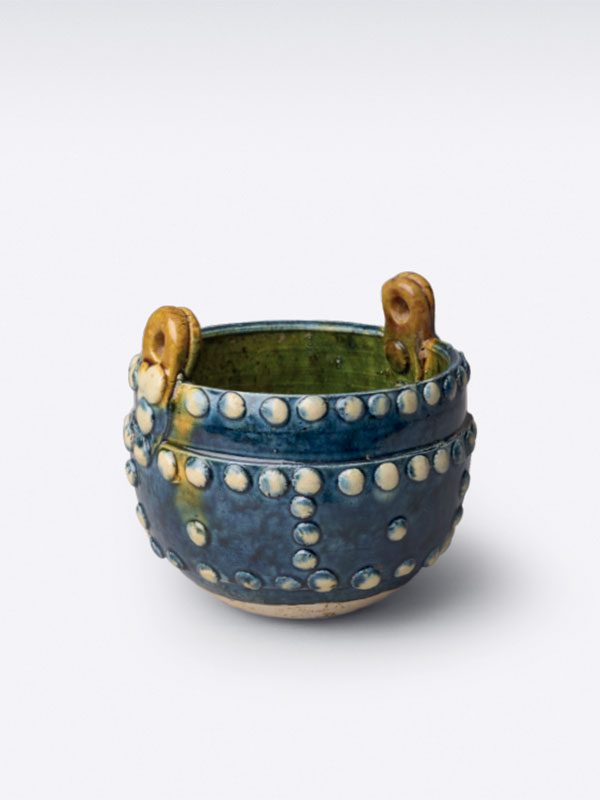Pottery blue-glazed miniature cauldron
China, Tang dynasty, 618 - 906
A miniature pottery model of a cauldron, the deep bowl shape supported on a circular, concave base, the sides gently sloping inwards as they reach the slightly recessed rim. Two double loop handles have been applied to the rim, to which they are fitted with imitation studs. Further rows of raised studs are applied to the body, both horizontally and vertically. The exterior is covered in a deep cobalt blue glaze, with the studs neatly picked out in cream. The loop handles are covered in amber glaze, and the interior is green. The blue glaze on the outside stops well short of the base, where it reveals the buff-coloured clay.
The fact that so many Tang dynasty pottery shapes closely copy metal forms suggests that they were especially produced to accompany the buried. It is obvious that a small, elaborately decorated pottery vessel such as this delightful miniature cauldron could not have been intended for practical use. The parallel between ceramics and metal, evident in the shape, is reinforced here by the application of pottery ‘studs’ that imitate the metal nails that would have been used to construct the original metal vessel. Miniature pottery cauldrons from this period are exceedingly rare, but a similar example, covered in a black glaze, was exhibited in 1959 at the Kyoto National Museum, along with a white-glazed example lacking the imitation studs.[1] Several metal examples complete with swing handles were exhibited in 1999 at the Kuboso Memorial Museum of Art in Izumi, Japan.[2]
1 Kyoto National Museum: Fine Art of Sui and Tang, Special Exhibition, Kyoto National Museum publication 1959, nos. 221 and 206
2 Special Exhibition of Tin-Bronze of China, Kuboso Memorial Museum of Art, Izumi, 1999, nos. 84-87, pp. 44-5
唐/巩县窑蓝彩鼓钉釜
此釜总体呈双耳提篮状,内外施大面积蓝釉,仅双耳施黄釉。周身饰以白色鼓钉,圆底,胎质细腻。釜常见于巩县窑瓷器中,为唐代茶事中烹水所用。此釜形制在唐代巩县窑所产的茶釜中较为少见,其器身较之多数巩县茶釜更为挺拔。

